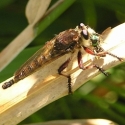Robber Flies / Mydas Flies
Robber Flies (family Asilidae) are the master predators of the fly world. Numbering close to 1,000 species in North America, they vary in size from 1/8 inch – 2 inches in length. They can be recognized by the bearded face and the hunched-back appearance of the thorax. Many hunt like flycatchers, darting out from a leaf or twig to catch a passing insect. The short, strong proboscis is used to stab and inject its prey with saliva that contains enzymes which paralyzes it and digests the insides. The fly then siphons up the liquefied meal. Some robber flies are bumble bee mimics. If you see an insect that looks like a bumble bee sitting on a leaf for any length of time, it’s probably a robber fly.
Mydas Flies include some of the largest flies. Some tropical species are more than 2 inches long. These black flies are sometimes mistaken for spider wasps, but they are harmless to humans. Some adult females do not feed. Adult males may take nectar. The larvae live mostly in decaying wood and and soil and are predatory on beetle grubs. They have well developed mouthparts for sucking bodily fluids from insect larvae. There are about 50 species in North America.
Disclaimer: The content of NatureSearch is provided by dedicated volunteer Naturalists of Fontenelle Forest who strive to provide the most accurate information available. Contributors of the images retain their copyrights. The point of contact for this page is: Loren Padelford.


